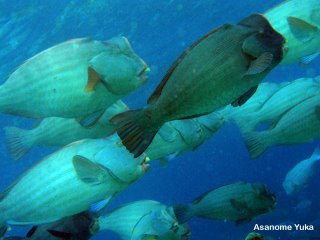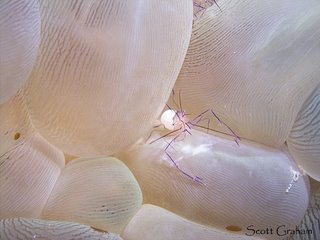Yes, it is indeed a"Nude Fest"!! Wait a minute......when we say "Nude Fest" here, we actually refers to a celebration of one of our most beloved underwater creatures - nudibranches.......
}xP
Don't get too excited yet!!! Hahahaha!!! Thecacera picta - white color variation. Picture by Sophia Chan
Thecacera picta - white color variation. Picture by Sophia Chan
 Chromodoris annae. Image by Geri Murphy
Chromodoris annae. Image by Geri Murphy
 Chromodoris tritos - Image by Lee Tiow Aun
Chromodoris tritos - Image by Lee Tiow Aun
 Flabellina exoptata. Image by Sophia Chan
Flabellina exoptata. Image by Sophia Chan
Nudibranch are sea slugs (soft-bodied snails) which does not have any shells in their adult form. The word "nudibranch" comes from Latin nudus meaning "naked" and Greek brankhia meaning gills. Most of them have externally retractable or contractible gills located around the back of the nudibranch. Some of them have their gills located around the sides of their body (example flabellinidae family).The head generally have two contractible rhinophores (used to detect odors) at the front of the animal.
 Chromodoris magnifica, with its gills at the back portion of the nudibranch. Image by Nina Ho
Chromodoris magnifica, with its gills at the back portion of the nudibranch. Image by Nina Ho
 Picture showing the rhinophores of a nudibracnh. Picture: Thecacera picta (yellow color variation). Has been dubbed 'Pikachu' after the famous Japanese animation character 'Pocket Monsters' - image by Lee Tiow Aun
Picture showing the rhinophores of a nudibracnh. Picture: Thecacera picta (yellow color variation). Has been dubbed 'Pikachu' after the famous Japanese animation character 'Pocket Monsters' - image by Lee Tiow Aun
 Flabellina type of nudibranch are examples of nudibranch that have gills positioned on the sides of their body. Image by Y. Keiko
Flabellina type of nudibranch are examples of nudibranch that have gills positioned on the sides of their body. Image by Y. Keiko
Nudibranch are hermaphrodites, they maintain both male and female sex organs with reproductive pores which is generally positioned on the right side of their necks. They will start to have contacts by either body touch or rhinophores contacts when they recognise another nudibranch that is from the same species and some courting will take place before they mate.
 Mating pair of nembrotha lineolata. The sex organ is located on the right neck of the nudibranch. Image by Lee Tiow Aun
Mating pair of nembrotha lineolata. The sex organ is located on the right neck of the nudibranch. Image by Lee Tiow Aun
Hypselodoris apolegma, laying eggs. Image by Sophia Chan
The choice of food for nudibranches are very varied, ranging from sponges, hydroids, tunicates, crustaceans to even members of their own species. This maybe because some of them have very strict preference of food, only eating certain species of prey.
 Pikachu nudibranch with their favorite food. Image by Lee Tiow Aun
Pikachu nudibranch with their favorite food. Image by Lee Tiow Aun
 Nembrotha lineolata feeding. Image by Lee Tiow Aun
Nembrotha lineolata feeding. Image by Lee Tiow Aun
Because of the lack of external shells on nudibranches, they have evolved some very interesting ways to defend themselves from predators. Some of them warn off their predators by their brightly colored body that indicates 'bad taste', some of them secrete chemicals to fend off predators, some of them mimic their food host so that their predators can't see them hidden among their food and there are even some that can simply swim away when they sensed danger (example spanish dancer).

The brightly colored and hard bodied notodoris minor that renders itself inedible by prey fish. Image by Nina Ho
Spanish dancer, one of the few types of nudibranch that can swim away from its predators. Image by Nina

Okenia nakamotoensis - fending off predators by its bright red color (Red means stop on traffic light while red in the world of nudibranch means "Stop!!! Don't eat me!!!". Image by Sophia Chan
Even with all these advanced adaptations to defend themselves, some fishes have developed the knowledge on how these nudibranches defend themselves and thus has developed some methods which the fish can eat some of the nudibranch. For example, some pufferfish and wrasses have developed a method to eat nudibranch by sucking them in and spitting them out very quickly several times to reduce the strenght of the chemical discharge each time the nudibranch is sucked in. They are such masters of self-defense even some other animals also try to mimic the appearance of nudibranch.Flamboyant cuttlefish has been suggested by some people to mimic the appearance and behaviour of nudibranches. Interesting isn't it!!

"Don't eat me......look at me, I'm so cute!!!" Thecacera picta - Image by Sophia Chan
That's it for this entry guys, hope you guys liked what we have got to share with you all Paradise-Loggers out there!!


















 Flabellina type of nudibranch are examples of nudibranch that have gills positioned on the sides of their body. Image by Y. Keiko
Flabellina type of nudibranch are examples of nudibranch that have gills positioned on the sides of their body. Image by Y. Keiko

 Pikachu nudibranch with their favorite food. Image by Lee Tiow Aun
Pikachu nudibranch with their favorite food. Image by Lee Tiow Aun






















































